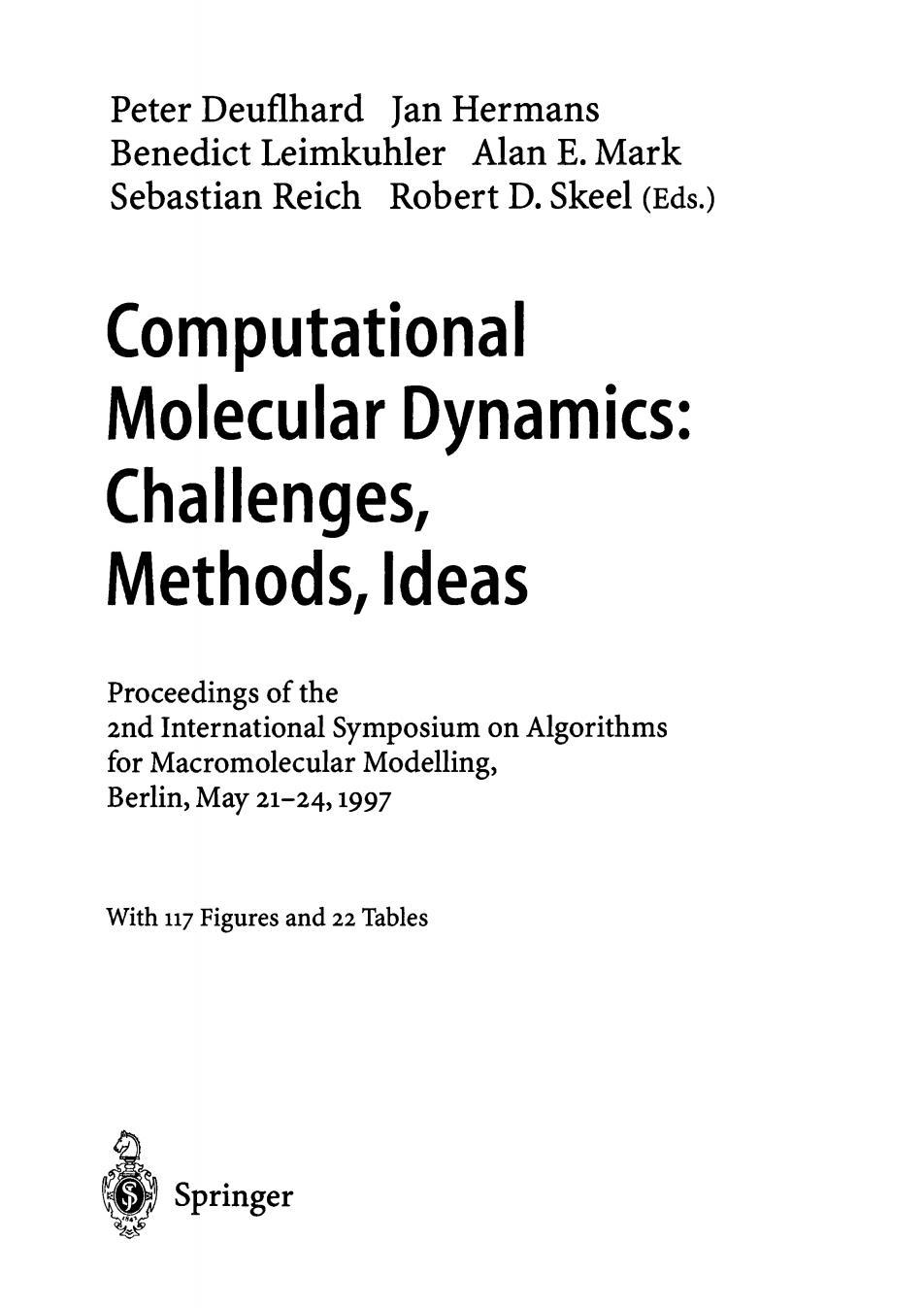
Peter Deuflhard Jan Hermans Benedict Leimkuhler Alan E.Mark Sebastian Reich Robert D.Skeel (Eds.) Computational Molecular Dynamics: Challenges, Methods,Ideas Proceedings of the 2nd International Symposium on Algorithms for Macromolecular Modelling, Berlin,May 21-24,1997 With 117 Figures and 22 Tables Springer
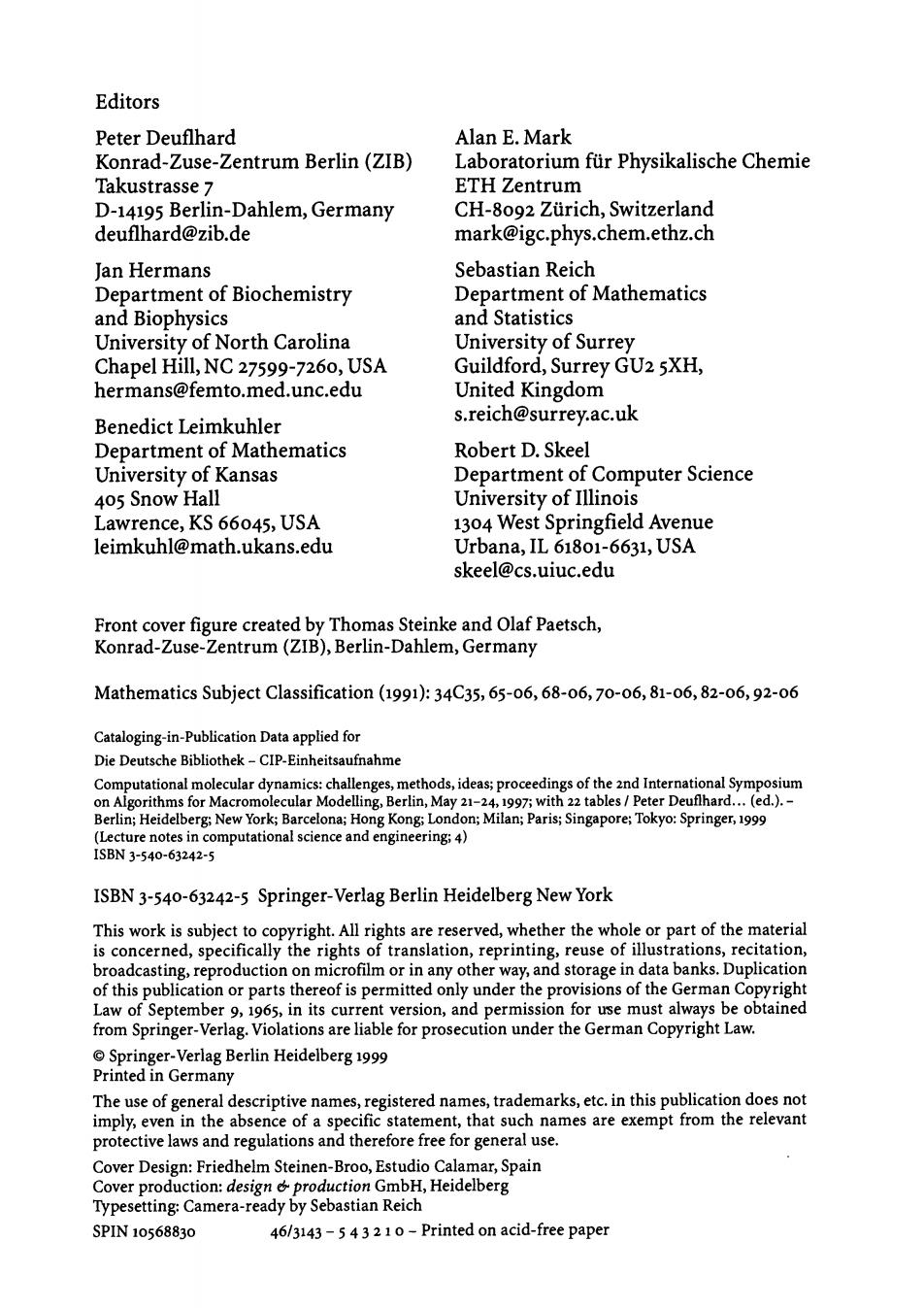
Editors Peter Deuflhard Alan E.Mark Konrad-Zuse-Zentrum Berlin(ZIB) Laboratorium fuir Physikalische Chemie Takustrasse 7 ETH Zentrum D-14195 Berlin-Dahlem,Germany CH-8092 Zurich,Switzerland deuflhard@zib.de mark@igc.phys.chem.ethz.ch Jan Hermans Sebastian Reich Department of Biochemistry Department of Mathematics and Biophysics and Statistics University of North Carolina University of Surrey Chapel Hill,NC 27599-7260,USA Guildford,Surrey GU2 5XH, hermans@femto.med.unc.edu United Kingdom s.reich@surrey.ac.uk Benedict Leimkuhler Department of Mathematics Robert D.Skeel University of Kansas Department of Computer Science 405 Snow Hall University of Illinois Lawrence,KS 66045,USA 1304 West Springfield Avenue leimkuhl@math.ukans.edu Urbana,IL 61801-6631,USA skeel@cs.uiuc.edu Front cover figure created by Thomas Steinke and Olaf Paetsch, Konrad-Zuse-Zentrum(ZIB),Berlin-Dahlem,Germany Mathematics Subject Classification (1991):34C35,65-06,68-06,70-06,81-06,82-06,92-06 Cataloging-in-Publication Data applied for Die Deutsche Bibliothek-CIP-Einheitsaufnahme Computational molecular dynamics:challenges,methods,ideas;proceedings of the 2nd International Symposium on Algorithms for Macromolecular Modelling,Berlin,May 21-24,1997;with 22 tables/Peter Deuflhard...(ed.).- Berlin;Heidelberg;New York;Barcelona;Hong Kong;London;Milan;Paris;Singapore;Tokyo:Springer,1999 (Lecture notes in computational science and engineering;4) ISBN3-540-63242-5 ISBN 3-540-63242-5 Springer-Verlag Berlin Heidelberg New York This work is subject to copyright.All rights are reserved,whether the whole or part of the material is concerned,specifically the rights of translation,reprinting,reuse of illustrations,recitation, broadcasting,reproduction on microfilm or in any other way,and storage in data banks.Duplication of this publication or parts thereof is permitted only under the provisions of the German Copyright Law of September 9,1965,in its current version,and permission for use must always be obtained from Springer-Verlag.Violations are liable for prosecution under the German Copyright Law. Springer-Verlag Berlin Heidelberg 1999 Printed in Germany The use of general descriptive names,registered names,trademarks,etc.in this publication does not imply,even in the absence of a specific statement,that such names are exempt from the relevant protective laws and regulations and therefore free for general use. Cover Design:Friedhelm Steinen-Broo,Estudio Calamar,Spain Cover production:design production GmbH,Heidelberg Typesetting:Camera-ready by Sebastian Reich SPIN 10568830 46/3143-5 4321o-Printed on acid-free paper
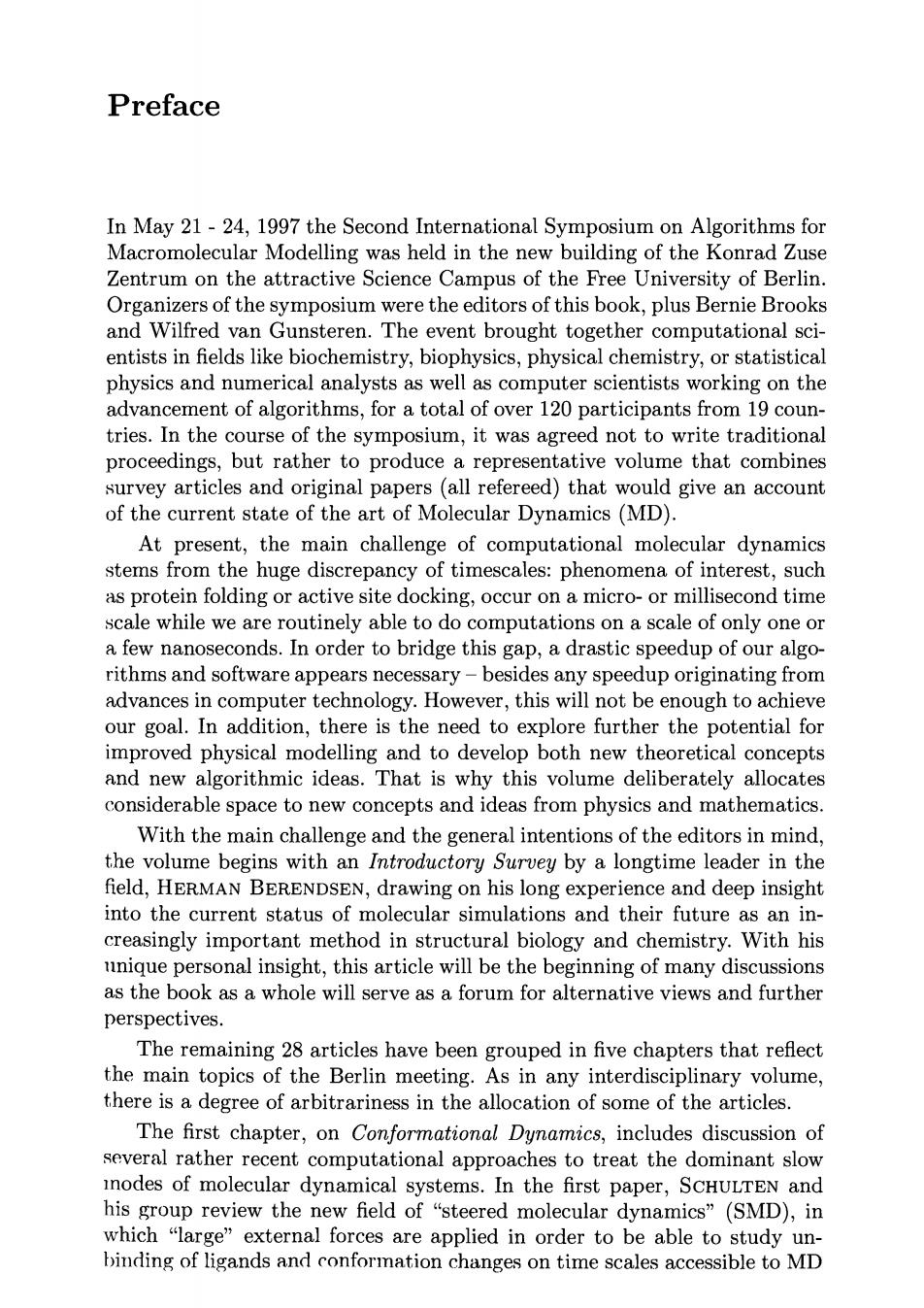
Preface In May 21-24,1997 the Second International Symposium on Algorithms for Macromolecular Modelling was held in the new building of the Konrad Zuse Zentrum on the attractive Science Campus of the Free University of Berlin. Organizers of the symposium were the editors of this book,plus Bernie Brooks and Wilfred van Gunsteren.The event brought together computational sci- entists in fields like biochemistry,biophysics,physical chemistry,or statistical physics and numerical analysts as well as computer scientists working on the advancement of algorithms,for a total of over 120 participants from 19 coun- tries.In the course of the symposium,it was agreed not to write traditional proceedings,but rather to produce a representative volume that combines survey articles and original papers (all refereed)that would give an account of the current state of the art of Molecular Dynamics(MD). At present,the main challenge of computational molecular dynamics stems from the huge discrepancy of timescales:phenomena of interest,such as protein folding or active site docking,occur on a micro-or millisecond time scale while we are routinely able to do computations on a scale of only one or a few nanoseconds.In order to bridge this gap,a drastic speedup of our algo- rithms and software appears necessary-besides any speedup originating from advances in computer technology.However,this will not be enough to achieve our goal.In addition,there is the need to explore further the potential for improved physical modelling and to develop both new theoretical concepts and new algorithmic ideas.That is why this volume deliberately allocates considerable space to new concepts and ideas from physics and mathematics. With the main challenge and the general intentions of the editors in mind, the volume begins with an Introductory Survey by a longtime leader in the field,HERMAN BERENDSEN,drawing on his long experience and deep insight into the current status of molecular simulations and their future as an in- creasingly important method in structural biology and chemistry.With his unique personal insight,this article will be the beginning of many discussions as the book as a whole will serve as a forum for alternative views and further perspectives. The remaining 28 articles have been grouped in five chapters that reflect the main topics of the Berlin meeting.As in any interdisciplinary volume, there is a degree of arbitrariness in the allocation of some of the articles. The first chapter,on Conformational Dynamics,includes discussion of several rather recent computational approaches to treat the dominant slow inodes of molecular dynamical systems.In the first paper,SCHULTEN and his group review the new field of "steered molecular dynamics"(SMD),in which "large"external forces are applied in order to be able to study un- binding of ligands and conformation changes on time scales accessible to MD

VI Preface simulations.The second paper,by HELMS MCCAMMON,surveys a wide range of different computational techniques for the exploration of conforma- tional transitions of proteins,including the use of stochastic dynamics with the Poisson-Boltzmann approximation as a simple solvent model.The ar- ticle by EICHINGER ET AL.combines several speedup techniques:multiple time stepping algorithms adapted to fit fast multipole methods(see also the last chapter of this book),the previously mentioned SMD technique,and GRUBMULLER's method of "computational flooding",which uses local po- tential modifications in order to successively drive the system to different low-energy basins.The novel approach taken by DEUFLHARD ET AL.em- ploys ideas from the mathematics of dynamical systems to construct certain almost invariant sets in phase space,which can be interpreted as chemical conformations;their algorithm also supplies patterns and rates of conforma- tional changes.In the last paper of this chapter,ToLSTUROKOV VIRNIK describe another use of dynamical systems tools and propose a simplified set of differential equations for the description of an observed hysteresis behavior in water adsorption-desorption of nucleic acids. The second chapter,on Thermodynamic Modelling,is devoted largely to methods for computing free energies and potentials of mean force.The paper by HERMANS ET AL.reviews experimental and theoretical techniques for studying the stability of protein-ligand complexes,including a new method for computing absolute free energies of binding with MD simulations,and summarizes recent applications from their laboratory.MARK ET AL.describe a new method to estimate relative binding free energies of a series of related ligands on the basis of a single simulated trajectory of a reference state in which a specially constructed,artificial ligand is modelled with a special "soft"potential function.KUCZERA describes a multiple-dimension approach by which conformation space is explored,while the potential of mean force is simultaneously computed.The joint paper from the groups of LESYNG and of MCCAMMON reviews an algorithm for the prediction of ionization constants in proteins;calculations of the relevant protein-solvent system are based on the already mentioned Poisson-Boltzmann equation.The paper by STRAUB ANDRICIOAEI employs the Tsallis statistics to speed up phase space sampling. In the final article of this chapter,NEUMAIER ET AL.construct empirical potentials for possible use in off-lattice protein studies. The third chapter,on Enhanced Time-Stepping Algorithms,opens with a personal account on long-timestep integration by SCHLICK.She assesses both the successes and the limitations of various algorithmic approaches including implicit discretization,harmonic/anharmonic separation of modes,and force splitting techniques combined with Langevin dynamics.The second paper, by ELBER ET AL.,describes a large step-size approximation of stochastic path integrals arising from Langevin dynamics -requiring,however,knowl- edge about both initial and final states.On the basis of a detailed case study ASCHER REICH argue that implicit discretizations should not be used with timesteps significantly larger than typical periods of the fast oscilla-

Preface VII tions.In the paper by BERNE,the r-RESPA multiple timestepping (MTS) method is described and applied in the context of Hybrid Monte Carlo meth- ods for sampling techniques such as J-Walking and S-Walking with the aim of a more rapid exploration of rugged energy landscapes.In the next pa- per,SKEEL IZAGUIRRE advocate the use of MTS in a mollified impulse method to overcome resonance instabilities that are inherent in the standard impulse method.Yet another MTS-like approach can be found in the paper by JANEZIC MERZEL,who suggest to split off a harmonic high frequency part of the motion and integrate that analytically.Finally,LEIMKUHLER demon- strates the stability of the recently proposed explicit symplectic integrators (with fixed timestep)in the numerical integration of rigid body motion over long time spans. The fourth chapter,on Quantum-Classical Simulations,deals with the integration of molecular systems,parts of which are modelled in terms of quantum mechanics,where a full quantum mechanical treatment would be impossible.In the first paper,JUNGWIRTH GERBER treat clusters of inert gases by calculating effective single-mode potentials from classical molecular dynamics which are then used in quantum calculations.An extension be- yond the separability approximation is also suggested.The quality of the quantum-classical molecular dynamics (QCMD)model compared with full quantum mechanics (QM)and the Born-Oppenheimer approximation(BO) is considered by SCHUTTE BORNEMANN in terms of approximation theory. They also suggest an extended QCMD model that may open new perspectives in the case of energy level crossings,where BO is known to break down.Re- cently developed structure-preserving numerical integrators for this QCMD model are given by NETTESHEIM SCHUTTE.Symplectic multiple timestep- ping variants of these integrators are derived in the paper by NETTESHEIM& REICH.An alternative scheme is presented by HOCHBRUCK LUBICH,who suggest that a type of mollified exponential integrators are especially well- suited for highly oscillatory systems such as QCMD and the Car-Parrinello approximation.The latter approximation is also used in the paper by MEIER ET AL.on ab-initio MD simulations of catalysis in a polymerization process. In the last paper of this chapter,IZVEKoV describes an algorithm for the calculation of absorption spectra based on exciton-phonon interactions. The fifth and final chapter,on Parallel Force Field Evaluation,takes account of the fact that the bulk of CPU time spent in MD simulations is required for evaluation of the force field.In the first paper,BoARD and his coworkers present a comparison of the performance of various parallel implementations of Ewald and multipole summations together with recommendations for their application.The second paper,by PHILLIPS ET AL.,addresses the special problems associated with the design of parallel MD programs.Conflicting issues that shape the design of such codes are identified and the use of features such as multiple threads and message-driven cxecution is described.The final paper,by OKUNBOR MURTY,compares three force decomposition techniques (the checkerboard partitioning method

VIII Preface the force-row interleaving method,and the force-stripped row method)in the context of a benchmark test problem. August 31,1998 Peter Deufthard Jan Hermans Benedict Leimkuhler Alan E.Mark Sebastian Reich Robert D.Skeel
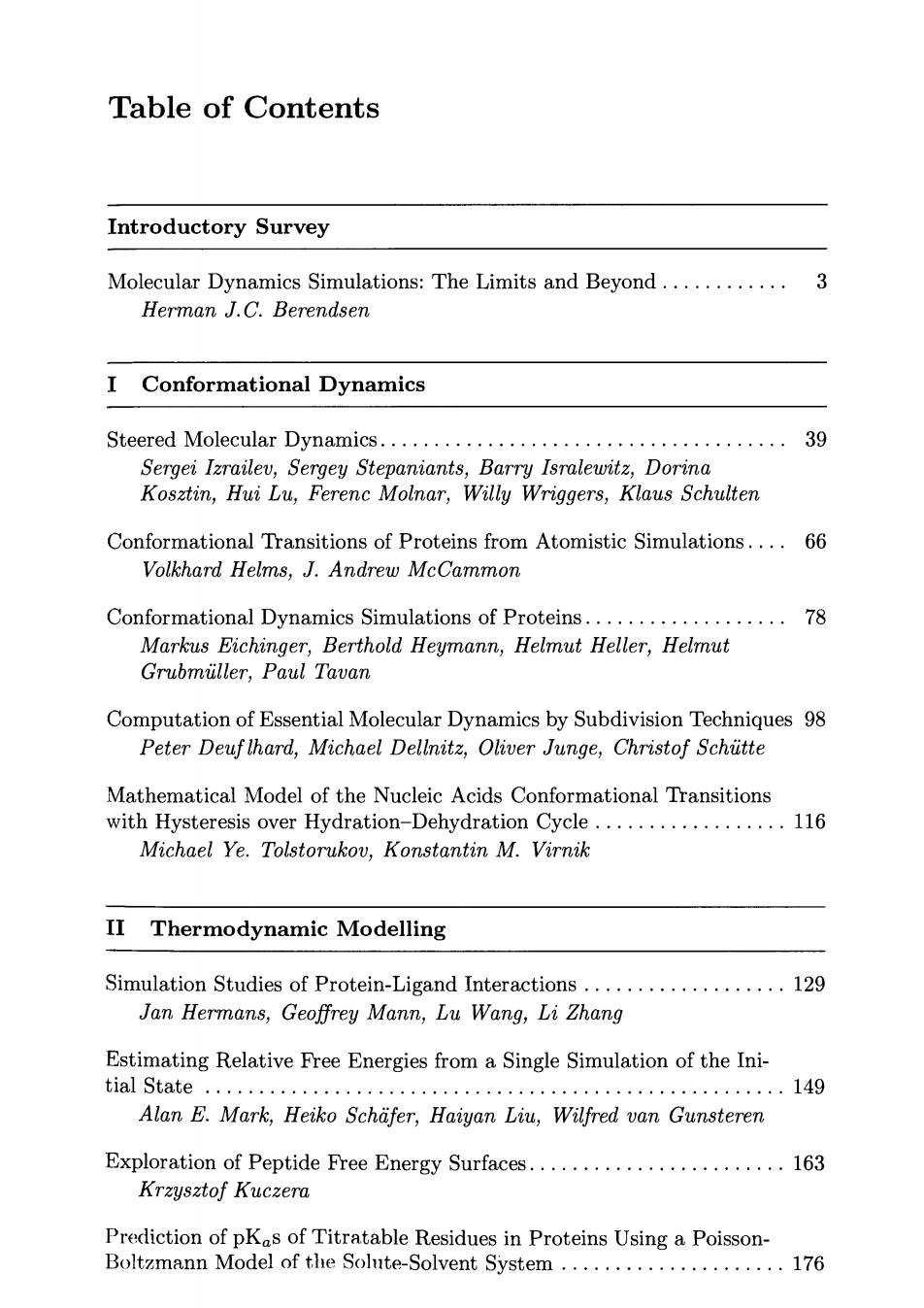
Table of Contents Introductory Survey Molecular Dynamics Simulations:The Limits and Beyond............ 3 Herman J.C.Berendsen Conformational Dynamics Steered Molecular Dynamics...................................... 39 Sergei Izrailev,Sergey Stepaniants,Barry Isralewitz,Dorina Kosztin,Hui Lu,Ferenc Molnar,Willy Wriggers,Klaus Schulten Conformational Transitions of Proteins from Atomistic Simulations....66 Volkhard Helms,J.Andrew McCammon Conformational Dynamics Simulations of Proteins.......... 78 Markus Eichinger,Berthold Heymann,Helmut Heller,Helmut Grubmiller,Paul Tavan Computation of Essential Molecular Dynamics by Subdivision Techniques 98 Peter Deuf lhard,Michael Dellnitz,Oliver Junge,Christof Schitte Mathematical Model of the Nucleic Acids Conformational Transitions with Hysteresis over Hydration-Dehydration Cycle..................116 Michael Ye.Tolstorukov,Konstantin M.Virnik II Thermodynamic Modelling Simulation Studies of Protein-Ligand Interactions...................129 Jan Hermans,Geoffrey Mann,Lu Wang,Li Zhang Estimating Relative Free Energies from a Single Simulation of the Ini- tial State................ Alan E.Mark,Heiko Schafer,Haiyan Liu,Wilfred van Gunsteren Exploration of Peptide Free Energy Surfaces......... 163 Krzysztof Kuczera Prediction of pKas of Titratable Residues in Proteins Using a Poisson- Boltzmann Model of the Solute-Solvent System.....................176

X Table of Contents Jan Antosiewicz,Elibieta Btachut-Okrasinska,Tomasz Grycuk, James M.Briggs,Stanistaw T.Wtodek,Bogdan Lesyng,J.Andrew McCammon Exploiting Tsallis Statistics... 197 John E.Straub,Joan Andricioaei New Techniques for the Construction of Residue Potentials for Protein Folding.………· …212 Arnold Neumaier,Stefan Dallwig,Waltraud Huyer,Hermann Schichl III Enhanced Time-Stepping Algorithms Some Failures and Successes of Long-Timestep Approaches to Biomolecular Simulations........................................227 Tamar Schlick Application of a Stochastic Path Integral Approach to the Computa- tions of an Optimal Path and Ensembles of Trajectories.............263 Ron Elber,Benoit Roux,Roberto Olender On Some Difficulties in Integrating Highly Oscillatory Hamiltonian Sys- tems..........................................................281 Uri M.Ascher,Sebastian Reich Molecular Dynamics in Systems with Multiple Time Scales:Reference System Propagator Algorithms........... 297 Bruce J.Berne The Five Femtosecond Time Step Barrier ......... :.,318 Robert D.Skeel,Jesis A.Izaguirre Long Time Step MD Simulations Using Split Integration Symplectic Method.……332 Dusanka Janezic,Franci Merzel Comparison of Geometric Integrators for Rigid Body Simulation......349 Benedict J.Leimkuhler IV Quantum-Classical Simulations New Methods in Quantum Molecular Dynamics of Large Polyatomic Systems.........365 Pavel Jungwirth,R.Benny Gerber

Table of Contents XI Approximation Properties and Limits of the Quantum-Classical Molec- ular Dynamics Model............................................ 380 Christof Schiitte,Folkmar A.Bornemann Numerical Integrators for Quantum-Classical Molecular Dynamics.....396 Peter Nettesheim,Christof Schitte Symplectic Multiple-Time-Stepping Integrators for Quantum-Classical Molecular Dynamics.............................................412 Peter Nettesheim,Sebastian Reich A Bunch of Time Integrators for Quantum/Classical Molecular Dynamics421 Marlis Hochbruck,Christian Lubich Applications of Ab-Initio Molecular Dynamics Simulations in Chem- istry and Polymer Science........................................433 Robert J.Meier Polarons of Molecular Crystal Model by Nonlocal Dynamical Coherent Potential Method...............................................442 Sergiy V.Izvekov V Parallel Force Field Evaluation Ewald and Multipole Methods for Periodic N-Body Problems .......459 John A.Board,Jr.,Christopher W.Humphres,Christophe G. Lambert,William T.Rankin,Abdulnour Y.Toukmaji Avoiding Algorithmic Obfuscation in a Message-Driven Parallel MD C0de...........................,,..。472 James C.Phillips,Robert Brunner,Aritomo Shinozaki, Milind Bhandarkar,Neal Krawetz,Attila Gursoy,Laxmikant Kale, Robert D.Skeel,Klaus Schulten Parallel Molecular Dynamics Using Force Decomposition.............483 Daniel Okunbor,Ravi Murty
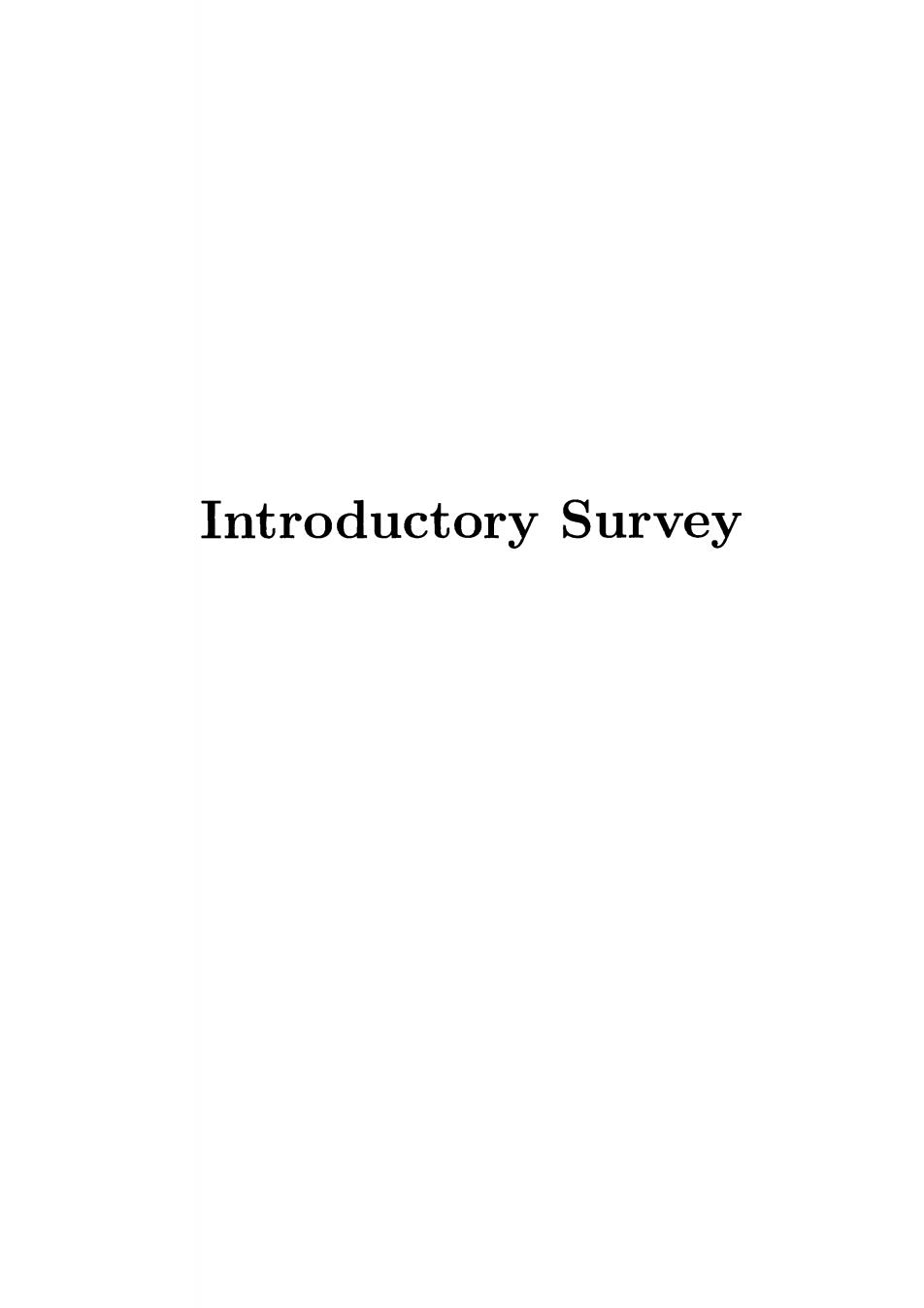
Introductory Survey